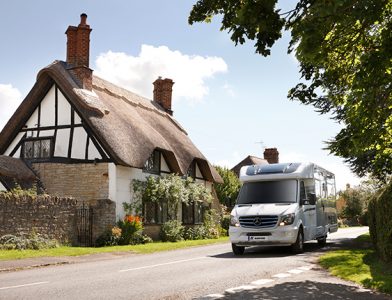Owning a motorhome gives you the freedom of the open road. And if that open road begins with the short hop across the Channel to France, the open road has practically no end.
France is our closest neighbour. That’s why so many Britons visit the country – principally for holidays. They totalled more than 10.3 million in 2019, according to the latest figures published by the Office for National Statistics (ONS).
Though it might be just a short cross-Channel journey away, however, remember that France is a foreign country, with rules of the road, laws and customs that may differ substantially to those you are used to at home.
So, if you are planning on exploring France in your motorhome, there is the little matter of getting across the stretch of water known as the English Channel.
So, how do you get to France, what are the routes, and how long does it take?
With all that in mind, the following advice is offered about taking your motorhome to France.
Ways to get to France in your motorhome
Le Shuttle
By far the quickest and probably the most convenient way to get your motorhome across the Channel is through the Euro Tunnel on the train service known as Le Shuttle.
That means first driving to Folkestone on England’s south coast – the route is well signposted from the M20, where you simply drive your motorhome onto the train. The journey lasts just 35 minutes until you disembark in Calais.
When using the tunnel, you may keep onboard any LPG tanks you use for your cooker, refrigerator or for heating provided the cylinders have a capacity of no more than 47kg and that they are less than 80% full.
The Camping and Caravanning Club currently offers its members a 10% discount when tickets for Le Shuttle are bought directly through the club.
Overground
Part of your adventure, though, might be the chance to wave a temporary goodbye to the white cliffs of Dover from the deck of a ship. In that case, you have a number of options – largely determined by where your destination in France will be:
Dover to Calais
- the shortest – 22 miles or so – and most familiar, is likely to be the Dover to Calais ferry, operated by two companies, DFDS Seaways and P&O Ferries;
- sea crossings with either company – who together offer a combined total of 39 sailings a day – take around an hour and a half between Dover and Calais;
- prices are calculated according to the exact dimensions of your motorhome – which you must provide at the time of booking – and larger vehicles are typically loaded first;
Dover to Dunkirk
- if you want to arrive a little further along the north coast of France, Dover to Dunkirk may be your choice – Dunkirk is a much less busy port than Calais, the tickets tend to be cheaper, and the journey time is still only around 2 hours;
- the route is operated by DFDS Seaways;
Newhaven to Dieppe
- DFDS Seaways also operates the ferry service between Newhaven and Dieppe;
- this might prove an even more relaxing crossing since both Newhaven and Dieppe are quieter ports than either Dover or Calais and the four-hour crossing gives you time to enjoy the cruise and enjoy a meal onboard;
Portsmouth to Normandy and Brittany
- if your destination is Normandy, Brittany or other points west in France, Brittany Ferries offers several routes, all starting from the port of Portsmouth;
- the route to Le Havre is billed as a “no frills” economy passage and takes around four and a half hours;
- sailings to the historic port of Caen in Normandy prove to be some of Brittany Ferries’ most popular crossings – though you might also want to book a cabin for the seven-hour crossing;
- Portsmouth to Cherbourg takes just three hours on Brittany Ferries’ Normandie Express;
- since the crossing takes 10 hours, sailings from Portsmouth to St Malo are overnight – a good time to enjoy a relaxing onboard meal as you watch the sea slip quietly by.
Whether you opt for the speed and convenience of the Channel Tunnel or choose a mini cruise across to France, therefore, our closest neighbour has never been easier to reach for your next motorhome tour.
But, so much for getting there – what are you likely to make of the driving in France and what should you know about taking your motorhome?
The driving
One of the main dangers may be the lure of the open road itself. Especially if you are chasing the sun, you might be tempted to drive much further in your motorhome in France than you are used to at home.
As a detailed study by the European E-Survey of Road Users’ Attitudes (ESRA) warned, it is essential to avoid driving fatigue, so plan your route well, and take regular breaks.
Documents
You need to remember your UK driving licence, but at the time of writing (September 2020), you do not need an international driving permit for France. Do note that this could change due to Brexit, so check with the Government website for clarification.
You must also have evidence of insurance for your motorhome since a minimum of third party cover is obligatory in France – as it is throughout the rest of Europe.
Check that your insurance covers driving in Europe and ask your insurer for a “green card” that confirms you are adequately insured for driving in France. The need for a green card is almost certain to increase once the UK has completed its departure from the EU as from the 1st of January 2021.
Also carry your registration and MOT documents too.
Kit
When driving in France, you must have onboard a warning triangle and a reflective jacket to wear in case of roadside emergencies together with a first-aid kit.
While it is no longer a legal requirement, it has been in the past and is, therefore, a good idea to continue to carry a breathalyser device.
Speed limits
Speed limits may vary, especially in rural areas, are likely to catch out the unwary and are frequently policed – with on the spot fines which vary according to the degree to which you have exceeded the limit.
That means up to €68 for a minor infraction (less than 12mph) but up to €3750 and three months in prison if you are caught for the second time speeding by more than 31mph.
Emissions
The RAC warns that in some French cities you also need to display a “clean air sticker” – a Crit’Air.
This costs £3.60 and you may face an on the spot fine of nearly £120 if you fail to do so.
Please note that this information is correct at the time of writing – September 2020 – so it is advisable to check routes, the documentation needed etc. from official sources when planning your trip, as they may change.




